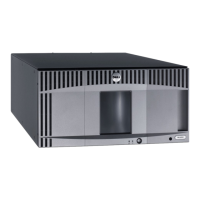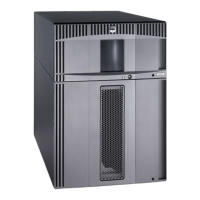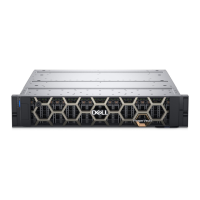Installing, Removing, and Replacing
file:///T|/htdocs/stor-sys/ML6000/en/html/ch08.htm[9/17/2012 1:50:35 PM]
"Initialization in Progress" screen displays.
11 Check the status of the LCB LEDs. All of its LEDs (blue, amber, and green) should be solidly lit for a short period of
time.
12 On the library's operator panel, a screen appears with instructions on how to proceed. Read the instructions and click
OK to close the instruction screen.
13 When the login screen appears, login with user name admin and password password.
14 Complete the next few screens to configure the host name and IP address(es) for your library. You are prompted to
choose whether to enable IPv6. When you are finished configuring, click Apply. A progress window indicates the
system is processing. When the progress window indicates "success," close the progress window.
Note: The system defaults to DHCP. For IPv4 only, you can deselect the DHCP option and assign a static IP
address (press the filled circle to the right of "Use DHCP:" to deselect). You cannot assign a static IP address for
IPv6.
15 The next screen lists one or more IP addresses assigned to the library. Take note of the addresses, then click Close.
The system logs you out of the operator panel and you return to the login screen.
16 Via an internet browser, connect to your library using one of the IP addresses assigned to the library in the previous
step.
A screen appears on the Web client with instructions on how to upgrade library firmware.
17 Upgrade library firmware to the most recent version.
Firmware downloads are available at
http://support.dell.com.
18 Restore the library configuration (see Saving and Restoring the Library Configuration). If you did not save a recent
configuration, you may need to manually restore your settings.
Note: If your last saved configuration contained down-rev library firmware, the library will restore the down-rev
firmware, overwriting the firmware you installed in step 17.
Adding, Removing, and Replacing Power Supplies
Library power is controlled at the individual power supplies and at the front panel of the library. The switch on the rear of each
power supply shuts down power at the input of the individual power supplies. The switch on the front of the 5U Library Control
Module provides power to all 5U Library Control Module and 9U Expansion Module power supplies. You can also turn off library
power using the Web client, if necessary.
Adding a Redundant Power Supply
These instructions explain how to add a second (redundant) power supply to a module. You may need to add a redundant
power supply to the library to make sure that the library does not go down (and become inaccessible) if its original power
supply happens to fail. The library automatically uses the redundant power supply if the first power supply fails for any
reason.
Note: The 5U Library Control Module and each 9U Library Expansion Module with drives must use at least one power
supply. You can add a redundant power supply to each module.
Installing one power supply in one module and another power supply in another module does not provide redundant
power; the two power supplies must reside within the same module.
Required tools: None
1 Save the library configuration (see Saving the Library Configuration).
2 Locate the vacant power supply slot and remove the cover plate. Save the cover plate in case the redundant power
supply needs to be removed at a later date.
3 Insert the new power supply into the vacant slot.
4 When inserting the power supply, make sure that you insert it correctly with its on/off switch located at the bottom of
the supply, below the handle. The power supply must be level to slide in smoothly.
5 Tighten the power supply's thumbscrews to secure the power supply to the library module.

